Titans Spaceplanes introduces the most revolutionary transportation concept since the airplane
It has been more than 70 years since commercial aviation started becoming mainstream. In recent decades, air travel has doubled and is deemed much safer than road travel. We've come far in just a few decades.
Space travel, however, is still in its infancy. Titans Spaceplanes, a spin off from Titans Space Industries, is set to change that in the most revolutionary fashion imaginable. The company has recently published its executive summary, and is now preparing its official launch.
Due to our close ties to the company, we also got the scoop on their project analysis, which you can find below.
But first, check out the executive summary video that lasts just two minutes.
The text below is taken from the company's analysis.
Titans Spaceplanes: Revolutionizing Space Travel and Space Launches
for Titans Spaceplanes & Space Technologies
Part of Feasibility Study for a Horizontal Take Off Single Stage to Orbit (HTO-SSTO) Spaceplane (November 2021- March 2023)
Conducted on behalf of Titans Space Industries (TSI)
March 10, 2023
Lead Author: Neal S. Lachman
Founding CEO, Titans Space Industries
Notice: The contents of this section of TSI's Feasibility Study include texts that are heavily inspired by or directly sourced from the Star-Raker study conducted by Rockwell.
Notice & Disclaimer
This Analysis (“document”) contains information about projects currently under proposal or under development by NSL & Co, LLC (NSL & Co.) and its associated organizations, including Titans Universe, Titans Space Industries, and Titans Spaceplanes & Space Technologies (Associates).
NSL & Co. and its Associates reserve the right to add, modify, or delete any information about projects, business models, strategies, projections and statements in this document, attachments, and appendices, if any, at any time, without previous warning.
This document and any references to projects and developments may be provided ‘as is' without any warranty or implied term of any kind.
The contents of this document are only made available to people, companies, and representatives of these companies, under acceptance of this notice, and only on personal license basis. Disseminating, forwarding, scanning, copying, sharing of (any part of) this document is prohibited.
As of this date, March 10, 2023, the information herein is accurate. NSL & Co. LLC and its Associates have compiled this document in good faith. However, no representation is made as to the completeness or accuracy of the information herein. In particular, the reader should be aware that though the authors feel the information is accurate to date, this information (or portions hereof) may be incomplete, may contain errors, or may have become out of date.
Use of this document by any third party for whatever purpose should not, and does not, absolve such third party from using due diligence in verifying the document's contents. Any use which a third party makes of this document, or any reliance on it, or decisions made based on it, are the responsibility of such third party. NSL & Co. LLC and its Associates accept no duty of care or liability of any kind whatsoever to any such third party, and no responsibility for damages, if any, suffered by any third party as a result of decisions made, or not made, or actions taken, or not taken, based on this document.
All methods of reproduction and distribution are expressly prohibited. No portion of this document, in whole or in part may be duplicated without prior, written approval.
© 2023 NSL & Co, LLC – Titans Space Industries – Titans Spaceplanes & Space Technologies
Introduction
The Titans Spaceplanes were first envisioned for the large space tourism and orbital infrastructure projects that Titans Space Industries (TSI) is preparing, including its own commercial space station. These projects require long-term routine operations comparable to commercial airline/ airfreight operations.
TSI's was founded by a group of partners with a combined 450 years of experience. The founding team includes a PE fund manager who raised more than $6 billion in capital, a Hall-of-Fame NBA basketball legend, a billion-dollar business strategist, a former MD of a Big 4 firm, and the former CFO of a Formula One racing team. The team brings more than 450 years of combined experience, and has worked more than a combined 200 years together on other projects. In 2020, the team halted all other projects to mainly focus on TSI's space and directly related projects due to their time- and capital intense nature.
TSI recently finalized its feasibility study for its spaceplanes project, and, based on the staggering conclusions, decided to spin off into a separate company: Titans Spaceplanes & Space Technologies or TSST (currently under formation). The TSI founding team consists of fifteen professionals; twelve of them, including yours truly, became the founding members of TSST.
During the company's spaceplanes research that lasted more than fifteen months, we realized that we could dominate the space launch industry once we get the spaceplanes up and running.
According to Fortune Business Insight, the global space launch services market is projected to grow from $14.21 billion in 2022 to $31.90 billion per year by 2029.
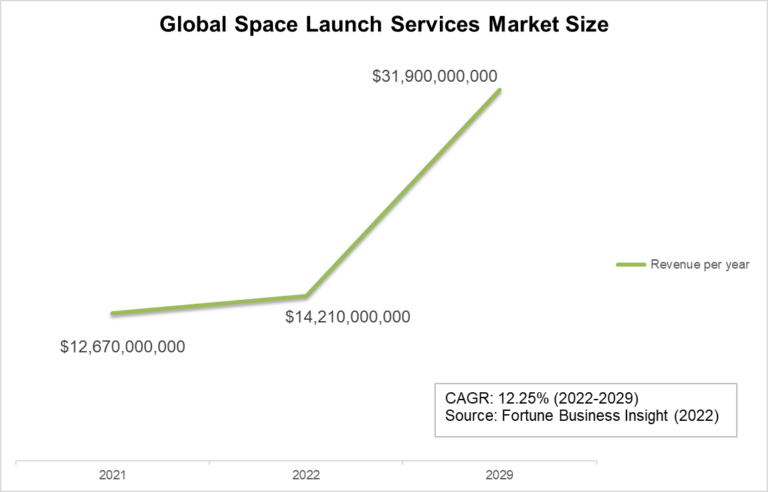
TSST‘s business model (and elevator pitch) is simple: “By providing routine, airfreight-like space launch services with our safe and efficient spaceplanes rather than inefficient and unsafe rockets, we aim to engage at least 1/3rd of this $32 billion annual market potential (by 2029), representing a guaranteed revenue stream of more than $10 billion per year.”
This, however, is just one of several large potential revenue streams for TSST. For details, please see Chapter “Financial Analysis” of TSI's Feasibility Study.
Strategic Rationale
Despite the media hype surrounding rockets like Elon Musk's Starship, routine space transportation, including human space travel, by means of rockets will not reach large numbers, basically due to the inherent risks of such vehicles.
For large scale space travel and cargo transport to reach levels like air travel/air cargo, the vehicles we use must operate like airplanes. At Titans Space Industries/TSST, we found the solution to this problem by looking at the past, especially the era when NASA and commercial aerospace engineers still dared to dream big and come up with truly revolutionary concepts like Saturn V and the Space Shuttle.
In the 1970s, the US government and NASA had incredibly ambitious plans to build an equatorial network of 60 solar power systems in Low-Earth Orbit from where solar energy would be beamed back to Earth. It would require around 30 years to complete the entire network – with the use of an ultra-safe, ultra-efficient, and fully reusable spaceplane.
Such a spaceplane would operate like an airplane, with the major difference that it would be able to reach space – Low-Earth Orbit in this case, something that airplanes cannot achieve.
Rockwell International came up with the Star-Raker, a huge wet-wing, horizontal take-off and landing spaceplane that would be able to carry large payloads to LEO, return safely to Earth – thanks to its 95-meters wide tri-delta wings.
The Star-Raker and its original purpose became the inspiration for our concept first generation of the Titans Spaceplanes.
TSST's preliminary designs are a slightly modified version of the Star-Raker's as a sign of respect to this beautiful design and to give the public a comparable vehicle, but the eventual Titans SpacePlane Gen 1 (TSPG1 or Titans Spaceplane) will benefit from major modifications and modern improvements, thanks to the advancements in terms of engineering, materials, technologies, and developments over the past 43+ years since the Rockwell engineers turned in their research to NASA.
We are aware of the challenges for a huge machine like the TSPG1, but our advisers and the TSI team concluded, after almost fifteen months of study, that a spaceplane like the Star-Raker is entirely possible. The development and manufacturing for the TSPG1 as planned by TSST (in terms of specs and number of vehicles) will cost approximately $2.5 billion over the stretch of five years.
Phase 1, the feasibility study for the development and manufacturing of TSPG1, has been concluded with the approval and publication of the underlying document. Phase 2, the set up of the initial R&D process (teams, staff, operations) has been initiated and will last through 2023. The full fledged R&D phase (Phase 3) will last through 2024. TSPG1 will be built from 2025 onward (Phase 4).
Over the course of the coming ten years, TSST will develop two generations of reusable launch vehicles, the first one will be a single-stage-to-orbit horizontal take-off, horizontal landing spaceplane. This means that it will be going to space in one piece, and function more like an airplane rather than a rocket.
Titans Spaceplanes are designed as a revolutionary space transportation system that eliminates the need for expensive launch facilities, vehicle assembly buildings, and (expendable or reusable) all-rocket boosters. Titans Spaceplanes can operate from any large airport equipped with cryogenic facilities, and it can carry a 93-ton payload into any 556-km (300 nmi) orbit; it uses multi-cycle airbreather propulsion, and it's a lightweight vehicle.
These qualities, among many others, contribute to the Titans Spaceplanes' operational flexibility, and can play key roles in fulfilling future earth/space transportation requirements.
Heavily borrowing from Rockwell's Star-Raker
Over the course of fifteen months, we invested several thousand hours researching spacecraft, from rockets to single-stage-to-orbit (SSTO) vehicles, from vertical takeoff (VTO) to horizontal takeoff (HTO) vehicles. What we found was remarkable, fascinating, and intriguing. However, from the dozen spaceplanes concepts we studied, one stood out as the most credible and entirely possible option: Rockwell's Star-Raker.
Rockwell, the incredible aerospace company that helped humans set foot on the Moon, was contracted by NASA to design and build the Space Shuttle; in the late 1970s, they were again contracted by NASA to come up with a design for a safe and efficient vehicle with the following quantitative objectives cq. requirements:
Total vehicle reusability – with many reuses
Rapid turnaround
Ferry capability with cargo between airfields
Minimized launch costs
High reliability of delivery
Ability to reach any LEO plane from alternate launch sites (KSC, VAFB and others) and return to the same site; includes single-pass orbits
Cargo security
To that end, the geniuses at Rockwell decided to pursue the Star-Raker, a concept invented by Rockwell engineer David A, Reed in the early 60s and presented in 1968. Rockwell's team, which included Mr. Reed, published their research findings in a 1978/1979 study wherein they stated that the Star-Raker:
“… [A]dapts existing and advanced commercial and/or military air transport system concepts, operations methods, maintenance procedures, and cargo handling equipment to include a space-related environment.
The principal operational objective was to provide economic, reliable transportation of large quantities of material between earth and LEO at high flight frequencies with routine logistics operations and minimal environmental impact.
An associated operational objective was to reduce the number of operations required to transport material and equipment from their place of manufacture on earth to low earth orbit.”
The general objective of Rockwell's research was:
“… [T]o improve system definition and to advance subsystem technologies for a horizontal takeoff, single-stage-to-orbit vehicle which can provide economical, routine earth-to-LEO transportation in support of a postulated Satellite Power Systems program. Specific objectives… were:
To improve the design definition and technical and operational features of the Star-Raker HTO-SSTO vehicle concept primarily using existing aerodynamic, aerothermal, structural, thermal protection, airbreather and rocket propulsion, flight mechanics and operations technology integrated into a total systems design.
To identify disciplines and subsystems in which the application of advanced technology would produce the greatest increase in system performance, and to advance technologies in specific areas.”
Rockwell's combined systems design/performance and technology development studies (1978/1979) produced a number of significant results.
Demonstrated, with end-to-end simulation, the ability of the vehicle to take off from KSC, cruise to the equatorial plane, insert into a 300 nmi equatorial orbit with 151,000-pound payload, and then to re-enter and return to the launch site; also to deliver a 196,000-pound payload with a due-East launch.
Devised a modified airbreathing engine cycle for operation in turbofan, air-turbo-exchanger and ramjet modes to provide an effective match with takeoff, cruise and acceleration requirements.
Showed that Star-Raker lower surface temperatures during re-entry are several hundred degrees lower than orbiter lower surface temperatures because of a lower wing loading.
When the team at TSI read the full Rockwell study more than a year ago, we were convinced that the Star-Raker design should be the one we model Titans Spaceplanes on; we've been studying the Star-Raker ever since. More than fifty years after the conception of the Star-Raker, experts are convinced that such a massive spaceplane can be built; we have 43+ years (since the Rockwell Star-Raker research) of technological, materials, and engineering evolution that will finally result in realizing Titans Spaceplanes, gratefully inspired by David Reed's Star-Raker.
This analysis includes a condensation of the important aspects of what TSST will achieve – heavily borrowing from the Rockwell research paper. We use Star-Raker features, and where appropriate and relevant, we include certain non-confidential aspects and contexts of Titans Spaceplanes to help the reader understand present day challenges, solutions, and opportunities.
Furthermore, since Elon Musk's SpaceX Starship is the most immediate comparable vehicle qua volume and supposed turn-around, we've decided to include a slightly edited version of the introduction and Chapter 1 of “The Mars Colonization Delusion,” an in-depth analysis the TSI team wrote about Elon Musk's plans for Mars and the Starship super-heavy rocket. Also see section “Comparison Matrix: Titans Spaceplanes vs Dream Chaser vs Starship” of this analysis.
Rockets: Awesome but Unreliable, Inefficient, and Dangerous
Currently, chemically propelled rockets are the only way for space travel. As explained in last year's Critical Analysis of Rocket Launch Systems, rockets are the most dangerous method of transportation ever invented. NASA learned the hard way that there are many unknown unknowns, and that with rocketry, considering known unknowns is not enough to prevent disasters. Due to its violent nature, required by the laws of physics, escaping Earth's thick atmosphere with vertically launched rockets will always remain extremely dangerous – no matter how advanced our technologies, engineering, and materials will be.
As of 2023, only twenty-four astronauts have gone beyond Earth's orbit. NASA's Apollo program (1968-1972) took 24 astronauts to the Moon, twelve of whom walked on the Moon's surface. Numerous space agencies are presently considering human spaceflight, but none, except NASA, have presented plans beyond Earth's orbit. NASA's Artemis 2 mission will be the agency's first crewed mission with four astronauts to the Moon's orbit in May 2024. This will be the first time in more than 50 years that humans will go to the Moon.
Most future missions, whether commercial or from space agencies, are inherently limited in terms of the number of people they can carry on top of their vehicles. Elon Musk's SpaceX is developing a super heavy-lift rocket that may be capable of carrying more than just four or five people. The SpaceX Starship will bring about a revolution in space travel, if it ever succeeds in reaching orbit and beyond. Millions of people are excited about humanity's future as a space-faring, inter-planetary species. Many think that Musk will build a self-sustaining million-person-city on Mars. Regrettably, most people don't realize that even with the Starship, a trip to Mars will take at least six, and most probably, eight to nine months. More importantly, most people aren't aware that they can't just take off to Mars whenever they want, or return any time they want, if ever, if they are lucky enough to survive (the journey to) Mars.
The following few chapters offer one major conclusion: Starships are not only incredibly dangerous, they are also impractical for the very mission they have been developed for. To be blunt: interplanetary travel and colonizing Mars (let alone terraforming the red planet) will not be be achieved with Starships. Once people realize the special, unique requirements of such gargantuan projects, Elon Musk's promises are quickly revealed as unrealistic.
As stated previously, TSST is taking an entirely different approach to space travel and space launches with spaceplanes, where chemical rockets aren't part of the equation, designed to allow efficient, quick, low-cost, and -most importantly- much safer space travel.
Before proceeding, we‘d like to emphasize that this analysis is not to discredit the rocket launch industry; Titans Space Industries (TSI) needs rocket launch companies to thrive so that we can steadily proceed with our projects. TSI will require between 20 and 30 orbital rocket launches from 2025 to 2030, creating a potential $1.5 to $3 billion revenue opportunity for the rocket launch industry. We'll launch some of the initial modules for the Titans Space Station in Earth's orbit with rockets.
The TSI/TSST strategy is that TSI will become a big (anchor) customer for TSST where the latter will be responsible of TSI's launches for the next three to five decades.
This analysis first and foremost serves to establish a discussion about the future of rocketry. The world doesn't need Earth-launched chemical rockets for LEO (for human space travel as well as space launches) purposes once spaceplanes like Titans Spaceplanes are operational, and also not for MEO, GEO, or deep space purposes once (Titans) nuclear powered spaceships become operational (from the 2030s).
The Tyranny of One Starship's Many Potential Points of Failure
This chapter. we borrow heavily from the many incredibly detailed analyses done by Common Sense Skeptics (CSS), a reviewer of this document. In one of their analyses, they conclude that the Starship is even more dangerous than the rocket that caused “the largest non-nuclear explosion on record”.
“The largest non-nuclear explosion on record is in fact a rocket. In July of 1969, the Russians were racing the Americans to the moon, and their rocket of choice was called the N1.
All four of the Soviet N1 vehicles exploded at various stages of launch, but it's the second one that's the most infamous. The N1, in its entirety in four stages, contained about 680 tons of kerosene, or RP-1, and 1,780 tons of liquid oxygen (LOX) – according to Wikipedia- when this 30-engine behemoth came crashing back to earth at a 45-degree angle.
The resulting explosion leveled the launch complex through shrapnel 10 kilometers away, and even half an hour later droplets of burning fuel continued to rain down from the sky. Two important things to note about this accident. As violent as this explosion was, it could have been much worse. As not only did 85% of the propellant not initially explode — likely due to the separation of stages and vessels, but the RP-1 kerosene and the LOX did not have a chance to coagulate into a gel, which would have made this disaster a worst-case scenario for destruction.
The kiloton estimates for this explosion ranged from one to over seven, which would have been half of a Hiroshima nuke. Had those chemicals all combined at once into gel, it would have been orders of magnitude more destructive.
Comparing the N1 and Starship; what was the largest rocket in the soviet arsenal is overshadowed by the proposed Starship specs, standing at 105 meters high compared to the 118 meters high Starship super heavy combo. These designs are nothing alike, but one major difference between them is that the N1 had eight smaller pressurized fuel vessels in the design in their four stages. Starship has two per stage, for a total of four, and they are massive by any comparison since they hold almost exactly twice the mass of propellants.
Also, where the N1 had complete separation between the RP-1 and the LOX vessels, the Starship has common bulkheads, which will rupture if the ship changes shape in any way. It is far more likely that a Starship explosion would consume all the fuel of each stage at the same time.”
For more than 50 years, the Soviet N1's held the record for the most engines —30 in total— ignited on a single rocket. As stated, all four N1 missions -they weren't tests- failed catastrophically, but on February 9, 2023, 31 of the planned 33 Raptor engines were test-fired on a Starship that lasted less than seven seconds. Space enthusiasts all over the world rejoiced, many claiming that we're entering a new phase of space exploration. Reality is, most people don't remember the N1, and they don't remember the disastrous ramifications of having 30 engines, let alone 33 as Musk had planned.
Before this event, on December 15, 2022, Starship conducted a single engine test, after which I made a comment to one of the enthusiastic SpaceX watchers on Twitter, stating, “33 points of failure on the most dangerous mode of transportation ever invented.” CSS replied, “And that's just the primary count. Secondary points (plumbing, controls, etc) are also x33.”
Recently, in preparation for this analysis, I asked CSS to expand on any points of failure they see for Starship. They responded:
We've covered most of them in the videos, but of greatest concerns would be the number of engines and the rat's maze of plumbing associated with them; the use of relatively thin stainless steel that's welded together over the inch-thick CNCed aluminum diamond lattice that gives additional structural support to the panels that are stir-welded into one contiguous tube; the common dome, which we always take a lot of flak for mentioning, but when pressures on either side of that dome can't cancel each other out, the dome will buckle, which will change the shape of the cylinder, and likely cause the dome to fail. If the dome fails, the whole vehicle fails. It's that simple.
Those are the big, obvious concerns. Others would include the heat shielding, the fins, and the giant atrium window they like to have in the CGIs. Until more detailed information about the spacecraft they intend to put into orbit is released, those are the greatest concerns we have at this point.
Casey Handmer, an astrophysicist, was asked on Quora to answer the question, “What are the major causes of rocket failures?” Handmer lists many causes, from faulty software to fuel leak from a faulty valve, and from premature engine cut-off to unknown reasons.
Another answer, from James van Laak, a former Senior Project Manager at NASA, summarizes the problem with rockets succinctly: “Rockets are complex, operate at high stress, and are tightly weight constrained. This naturally leads to small margins and little room of error or under-performance.”
There are many known unknowns that can lead to mission failure, which is why meticulous planning and record-keeping, testing, trialing, and theorizing are part of the rocket design team's job. The most dangerous aspects, however, are the unknown unknowns, the issues that aren't even on our mind, that can wreak havoc and cause human deaths.
The Laws of Physics don't Agree with Rockets
As I write in my Critical Analysis of Rocket Launch Systems:
Clearly, a rocket launch is a sequence of controlled explosions. That sounds really cool, but what makes rockets awesome, fascinating, and powerful to see in action, also makes them most vulnerable, highly inefficient, and utterly dangerous.
Chemical rockets are inherently risky and dangerous, and while there are many improvements planned, the very violent nature of rockets on Earth is and will always be unavoidable.
All rockets, including the Starship, are at risk due to some well known limitations, the most famous one being “The Tyranny of the Rocket Equation”.
NASA's Space Shuttle flight engineer Don Pettit provides the best summary of this equation, which was first coined in 1903 by Russian scientist Konstantin Tsoilkovsky who applied Newton's Third Law to rockets – a technology that wasn't available in the real world until WW2.
Pettit explains:
Tyranny is a human trait that we sometimes project onto Nature. This projection is a form of rationalization, perhaps a means to cope with matters that we cannot control. Such is the case when we invent machines to free us from the bounds of Earth, affecting our escape into space. If we want to expand into the solar system, this tyranny must somehow be deposed.
Rockets are momentum machines. They spew gas out of a nozzle at high velocity causing the nozzle and the rocket attached to it to move in the opposite direction. Isaac Newton correctly defined the mathematics for this exchange of momentum in 1687. Conservation of momentum applied to a rocket was first done by Russian visionary and scientist Konstantin Tsiolkovsky in 1903. All our rockets are governed by Tsiolkovsky's rocket equation.
The rocket equation contains three variables. Given any two of these, the third becomes cast in stone. Hope, wishing, or tantrums cannot alter this result. Although a momentum balance, these variables can be cast as energies. They are the energy expenditure against gravity (often called delta V or the change in rocket velocity), the energy available in your rocket propellant (often called exhaust velocity or specific impulse), and the propellant mass fraction (how much propellant you need compared to the total rocket mass).
The violent escape from Earth's thick atmosphere -with the help of hundreds of tons of propellant- is a necessity for rockets, since, for the time being, there's no other way to go to space. Space Law blogger Alex Li, summarizes the physics behind it as following:
At its core, rocketry is highly dependent on Newton's three laws of motion. According to Newton's first law, a rocket will not move until acted upon by another force. A propellant can provide this impetus by creating a forward-moving propulsion force called thrust. Thrust is generated by the propellant in line with Newton's third law by, depending on the type of rocket engine, some form of reaction that causes mass to be expelled backward through a rocket's nozzle. How fast this rocket travels will depend on, as described by Newton's second law, the magnitude of the thrust created.
The laws of physics, along with many potential points of failure (human, technical, or material) make rocketry incredibly susceptible to catastrophe. No amount of risk analysis will ever be able to accurately predict the probable number of rocket accidents, mainly due to the unknown unknowns. Harry W. Jones writes in the introduction of his research paper for NASA Ames Research Center:
Before Challenger, management thought that the chance of an accident was 1 in 100,000. Afterwards, Probabilistic Risk Analysis (PRA) found a roughly 1 in 100 chance of a Shuttle failure. The number of planned Shuttle flights was greatly reduced. Attempts were made to strengthen the NASA safety culture, but the Columbia tragedy, due to recurring but neglected ice damage to the heat shields, was again attributed to poor safety culture and the normalization of deviance. The second tragedy again confirmed the Shuttle's roughly 1 in 100 risk and the Shuttle program was ultimately terminated. Later launch designs reverted to the safer Apollo configuration, with a hardened capsule, launch abort escape, and the crew placed above the rocket tanks and engine. The ultimate cause of the Challenger tragedy was neglect of risk in Shuttle design.
As if things weren't bad enough in the case of relatively small vehicles that were carrying a small number of humans, the issue of risking the lives of 50 or -as Elon Musk plans for his Starships- 100 space travelers aboard potentially the world's most dangerous vehicle, will become reason for project delays, and even cancellations of many ambitious space programs when just one accident will happen, and happen it will.
Human-Rating Standards
Before any spacecraft can carry humans on board, they need to go through a rigorous certification process. As per Wikipedia, for commercial spacecraft, “NASA Commercial Crew Program human-rating standards require that the probability of a loss on ascent does not exceed 1 in 500, and that the probability of a loss on descent did not exceed 1 in 500. The overall mission loss risk, which includes vehicle risk from micrometeorites and orbital debris while in orbit for up to 210 days, is required to be no more than 1 in 270. Maximum sustained acceleration is limited to 3g.”
Chapter 3, Technical Requirements for Human Rating, of NASA's Procedure Requirements concerns the launch abort requirements, which is —as of yet— completely lacking in the Starship design. Critics are wondering how and when Starship would get a human rating approval from NASA.
Concerning Musk's design decision for SpaceX vehicles, CSS provides us an outstanding analysis of the (lack of an) abort and escape system, as well as the explosive risks:
“… All current human rated space vehicles have the ability to rip the humans aboard away from a catastrophic failure – most of them using a tractor rocket mounted at the nose of the vehicle. That rocket is then discarded in space once the crew are safely through the atmosphere.
Crew dragon, which Musk delivered five years late, does not use such a system; it instead uses rockets built into the walls of the manned capsule, which means the astronauts are sitting on this potential bomb the entire time they're in space.
The one demonstration they conducted before setting up the demo mission with Bob [Behnken] and Doug [Hurley] was preceded by a SpaceX test on a returning capsule that accidentally blasted it into dust.
Back in September of 2019, Scott Manley tweeted Elon Musk, and asked him about the possibility of having a pad abort system, to which Musk replied they don't have this system, but maybe they should think about it. In December of 2019, Everyday Astronaut did an episode about how SpaceX was not developing the system, and still to date no such system has been announced, which pretty much means nobody is setting foot inside a Starship – and that includes their ridiculous point-to-point travel proposal that we cut to ribbons in episode 8.
Of course, everything we've discussed so far assumes SpaceX can get one of these vehicles into orbit and land it again safely — something that recent launches have yet to prove… Here are some key takeaways that should demonstrate just how far Musk has yet to go.
Forget the fact that no one has any clue what the inside of this vehicle is going to look like, and SpaceX has shared absolutely no details in that regard. Instead, let's break down how this latest craft exploded where obvious structural weaknesses exposed themselves during the flip maneuver on landing.
Although three engines fired up, two of them had shut down again before landing, and one of those had ruptured a methane line causing orange fire to wash up the vehicle as it landed. When it landed, the vehicle bounced off the ground because the landing legs SpaceX installed are ridiculously useless. In fact, three of them were swinging in the wind as it landed, and came to rest with a leaning angle. That fire continued in the skirt, eventually erupting out the side of the craft and launching it a second time.
The first indication this was going to end poorly is a deformation in the nose cone… as the bottom portion of the rocket was forced upwards from the explosion. Then the bottom portion of the craft tore apart like paper as the methane tank above it ruptured —except that's not the methane tank. That's the LOX tank; the methane tank is supposed to be the higher tank by all accounts, and LOX doesn't explode or burn on its own, which means the single dome separating the locks from the methane had to have been breached on landing —exactly like we said it would, way back in episode 1. The resulting explosion tossed this 50 meter tall vehicle like a toy.”
Probability of Rocket Failure
While certain errors can be smoothed out, and certain materials can be replaced after analysis, review, and evaluations, certain design issues are highly unlikely to change without a complete redesign/overhaul. This puts space travelers at high risk.
The safest rocket in history was the Delta II with a 98% mission success rate. NASA's own Space Shuttle had a 98.5 percent mission success rate with a 99.3 launch success rate; one shuttle exploded on reentry.
Let's suppose the Starship miraculously gets the human-rated certification, we'll be lucky if the Starship's failure rate will be below two percent. We have to imagine the hypothetical situation of a Starship failure with people on board – no matter the number of people, 100, 50, or just 2, and it doesn't matter whether that occurs during the first or 100th mission or during launch, a journey, or landing, it will force the entire crewed space travel industry to a grinding halt. How many rocket launch companies will survive such uncertain times?
When the Challenger disaster happened on January 28, 1986, the space shuttle program was shut down for almost three years. Its track-record of nine successful prior missions didn't matter anymore at that point.
The combination of known unknowns, as much as a risk analysis allows, with the unknown unknowns caused by who-knows-how-many additional potential points of failures (e.g. viewing windows, belly-flop maneuvers for landing) of a Starship, will forever doom chemical rockets to the realm of highly unreliable and utterly unsafe vehicles – especially for humans.
Space Shuttle Flight Engineer, Don Pettit, cited above, stated in the same essay:
A veteran astronaut who has been to the Moon once told me, “Sitting on top of a rocket is like sitting on top of a Molotov cocktail”. I took his comment to heart by first weighing a bottle of wine, emptying the bottle, and weighing it again. Simple engineering analysis allowed me to estimate and compensate for the density difference between wine and gasoline (which, for this particular vintage, I am sure was not much different). A Molotov cocktail was measured to be 52% propellant. So sitting on top of a rocket is more dangerous than sitting on a bottle of gasoline!
Space travel beyond Earth's orbit for the masses, with the help of a chemical rocket like the Starship, will remain a fantasy for many years to come, most likely forever.
Besides the Titans Spaceplanes, TSI offers two alternative vehicles for quick, efficient, and -most importantly- ultra-safe (deep) long distance space travel as essential parts of its projects. The first is a nuclear propelled spaceship, launching from Earth's orbit (not surface), which will be operational by 2027-2028, and the second is a sophisticated orbital launched spaceship. In both cases, there is no tyranny of the rocket equation that forces accepting risking human lives atop an explosive cylindrical stainless steel skyscraper.
Furthermore, while Musk is focused on Mars, TSI is focused on Low Earth Orbit and the Moon.
Interplanetary travel for the masses, i.e. on a large scale, with the help of a chemical rocket like Starship, will remain a fantasy for many years to come, most likely forever if they cannot resolve some core issues (on-orbit refilling, for example). Beyond the above stated safety concerns in terms of Starship rocket design, there are several major cumbersome processes and phases in the stages after launch.
The Rocket Industry's Orbital Refilling Fantasy
Industry players like ULA and Elon Musk's SpaceX have envisioned on-orbit refilling of their rockets, an incredibly dangerous and cumbersome process, if it ever would becomes a reality, which as we explain in this chapter, is highly doubtful. Titans Spaceplanes can, however, easily make orbital refilling a reality due to its air tanking-like capabilities, massive tanker capacity possibilities, and airplane-like operational efficiencies.
As this chapter will explain, we are of the opinion that only huge spaceplanes like Titans Spaceplanes can fulfill the deep-space dreams of current rocket industry players. This also means, automatically, that the rocket industry needs TSST to succeed, especially when their own on-orbit dreams will be shattered by reality.
Furthermore, as explained before, the world doesn't need Earth-launched chemical rockets for LEO (for human space travel as well as space launches) purposes once spaceplanes like Titans Spaceplanes are operational, and also not for MEO, GEO, or deep space purposes once (Titans) nuclear powered spaceships become operational (from the 2030s or even before).
Critical Issues for Rocket On-Orbit Refilling Concepts
The Tyranny of the Rocket Equation, mentioned in the previous chapter, also renders rockets as the most inefficient mode of transportation. Don Pettit compares rocket mass fractions to those of other vehicles. He lists the approximate numbers for propellant (or fuel when air is used as the oxidizer) to illustrate the general categories of mass fractions:
Vehicle | Percent Propellant (fuel) |
Large Ship | 3 |
Pickup Truck | 3 |
Car | 4 |
Locomotive | 7 |
Fighter Jet | 30 |
Cargo Jet | 40 |
Rocket | 85 |
In other words, on average, a rocket, including Starship, will consist of up to 85% propellant, and only 15% structure and payload. It's also understood that about the same percentage of that propellant will be used to escape Earth's thick atmosphere. That is why, in order to start their journey to Mars, Starships will need to have their tanks refilled on-orbit.
On the Mars & Beyond section of the SpaceX website, they write about on-orbit refilling:
Starship leverages tanker vehicles (essentially the Starship spacecraft minus the windows) to refill the Starship spacecraft in low-Earth orbit prior to departing for Mars. Refilling on-orbit enables the transport of up to 100 tons all the way to Mars. And if the tanker ship has high reuse capability, the primary cost is that of the propellant, and the cost of oxygen and methane is extremely low.
This vision is not grounded in reality; orbital refilling is most likely never going to happen at the scale and frequency as Elon Musk envisions and requires for Starships.
Each future Starship taking off from Earth's surface will consist of two stages, the first stage is the so-called reusable Super Heavy booster at the bottom half, and the Starship itself, on top, is stage two. According to the latest iteration as per SpaceX, Starship will stand 120 meters (394 ft) tall, almost equally split between the two stages. We leave the in-depth explanation of Starship design shortcomings to the likes of experts such as CSS (see the Starship and Mars analyses series on their YouTube channel).
SpaceX is developing two versions of Starship. One for humans and cargo transport, the second for propellant cargo. As Pettit explains in the above cited essay, most of a rocket's fuel will be spent in the effort to leave Earth. As such, since most of the on-board propellant of the Super Heavy booster will be expended in the effort to escape Earth's thick atmosphere, each Starship's tanks will need to be filled up with propellant (liquid methane [CH4] as fuel and liquid oxygen [LOX] as oxidizer) before starting the journey to the red planet. This process is known as, orbital refilling/refueling or on-orbit refilling.
We believe small or even medium scale orbital refueling for chemical rockets and spacecraft (such as satellites), as Orbit Fab intends, or at the Titans OrbitalPort Space Station, will be possible later this decade. In fact, it were the Russians who invented a refueling mechanism for their MIR station. The ISS gets refueled every few weeks. However, compared to that small amount of fuel, anything for a huge rocket like the Starship would be a Herculean task. Refilling hundreds of tons of fuel per Starship may be one of the rockets most important bottlenecks at the start of its journey, and they add unknown (amounts of) points of failure for Elon Musk's deep space projects.
The dangers start at the depot on Earth. CSS explains (Starship: Episode 5) the dangers of the huge amounts of fuel needed for orbital refilling – per Starship.
The Starship carries 1,200 tons of propellant. the Super Heavy carries another 3,400 tons. A tanker would have another 100 tons in the payload compartment, but we'll run this as if it's a crewed mission and then we're going to compare the results against the nuclear bomb that took out Hiroshima. 4,600 tons of propellant is 4.6 million kilos. According to epa.gov, 4.6 million kilos of methane contains 255 billion BTUs of energy. 255 billion BTUs equates to 64 kilotons of TNT, and the nuclear bomb that wiped Hiroshima off the map was a 15 kiloton device.
So Super Heavy fully loaded with the starship is equal in potential energy to about four Hiroshimas… with rockets it's never if one of them is going to blow up it's a matter of when.
One commenter's attempts to refute this and some other claims made in the episode resulted in the following answer from CSS:
You SHOULD have began at the episode called Nuclear Concerns, because we address quite a lot of these exact same, incorrect, types of statements. Starting with the comparison of SS to N1. N1-5L is an historical precedent for the type of outcome for an on-the-pad explosion with half the propellant load.
Estimates of 1-7 kilotons with only 15% of propellants detonated. We'll stand by our numbers until we are proven right or wrong when StarShip explodes on the pad, especially given the effects of the Beirut explosion. We won't have to wait long. First orbital attempt, most likely.
Your assessment of SS not requiring SH for trips over 10,000km is speculation, not fact.
Your fuel costs argument is incoherent, and is worded against your attempted point.
The spacesuit argument is dismissed. Ordinary people will not be able to handle the forces without a flight suit, and containing body fluids will be key in this system incurring weightlessness. Covered in Episode 8 PTP. If this is an argument about the pax capacity of the CGI ship, take it up with Shotwell. We used her numbers.
Your fuel transfer paradigm doesn't exist, so this is speculation.
StarShips headed to Mars are single-purpose vessels, not reusable. To get the next crew to Mars, you need another ship. We differentiate between tankers and Starships. You apparently didn't.
Sloshing the fuel between vehicles in a tail-to-tail configuration was dismissed as unworkable already. The CGI examples they use now are side-by-side, connected at the midpoint. But, please, by all means, demonstrate how that would work by reducing velocity. Propellant boil-off is of little consequence if you can't transfer it in the first place. But, yes, that's an additional factor to consider.
Many arm-chair space experts would deem people like CSS and yours truly as Space Luddites, as if we were opponents of development in space. On the contrary, I believe very much in the colonization, commercialization, and industrialization of Space, especially Earth's Moon, but we have to keep things realistic. It's of no use to try inventing Star Trek or Star Wars technology – we aren't living in movies. We can't travel at light-speed, we can't travel to Mars in a week, or visit the Sun. Heck, we can't even launch rockets without scrubbing launches, and even outright failing (exploding) now and then.
As explained before, orbital refilling at a large scale will most likely remain another major fantasy.
Nevertheless, that doesn't stop people from fantasizing. The delusion with orbital refilling is so big nowadays that some (including NASA) are advocating for smaller rockets, which would rendezvous with an orbital propellant depot, fill up the tanks, and then fly off/cruise to deep space. The premise of the proposal, at first, seems to make sense, were it not for the immense dangers of rockets exploding above our heads every now and then during a risky multi-hour refilling event. As explained in the previous chapter, we have to move away from or at least drastically reduce utilizing chemical rockets.
Musk doesn't disagree with the premise either; SpaceX got some goodies from NASA to figure it out. Nevertheless, in the real world, Starships are not shrinking in size on the design table. Starship is indeed the largest rocket ever designed, and as you may gather, it's a curse rather than a blessing. Starships need to refuel on-orbit in order to speed up on departure and to slow down upon arrival.
Small scale orbital refueling aside, nobody has proven it on a larger scale, and as of yet, we don't have the technology to store and transfer fuel from one rocket/vehicle/depot to another in LEO. To reiterate, it's the huge scale, gigantic quantities, and frequency, not the concept of orbital refueling itself that is going to cause delays, disasters, or deaths. Remember, all this on-orbit activity will play out in Earth's Low-Earth Orbit, most likely between 100 and 200 kilometer altitude. Accidents that may result in explosions will accelerate the Kessler Syndrome, which is disastrous for LEO activity.
SpaceX presented an aft-to-aft refueling concept, which CSS analyzed to death – literally. Not long after CSS published their analysis of this aft-to-aft paradigm, it was announced that SpaceX will not pursue aft-to-aft and instead go for a side-by-side refilling process. Check out that episode for detailed analysis and information on orbital refilling.
The fastest cars in the world are expected to achieve around 498 km/h (~310 mph). That's a fraction of the orbital speed something up there is traveling. Orbital velocity in Low-Earth Orbit is between 6.9–7.8 km/s (24,840–28,080 km/h or 14,430–17,450 mph). This orbital velocity is not only incredible fast, it's also dangerous for maneuvering.
As CSS posits:
If the vehicle slows down significantly, its orbit will degrade, just as if it speeds up, it will climb further away from Earth into a higher orbit until it leaves LEO. How do they expect to slam on the brakes and maintain their velocity?
This would have been a significant dilemma for pairing Starships aft-to-aft (canceled now), and is still an orbital mechanics/astrodynamics hurdle for Starships current side-to-side refueling concept. Due to the incredible velocity, and due to this all being in the near-vacuum of space, it's nothing compared to aerial/in-flight refilling where aircraft can use the laws of aerodynamics to their benefit.
In space, when two objects (e.g. Starships) are positioned side to side, it will look like there's no movement – they will appear as if they're stationary. Pairing/coupling these objects should be relatively straight-forward with the help of thrusters. However, the process of transferring tons of propellant from a tanker to a Starship introduces many dangers with many additional potential points of failure.
Since orbital refilling would occur at near-zero gravity, liquid fuel in the Starship tanker will float like everything operating in micro-gravity; it won't be simply draining into the receiving Starship. There will have to be some kind of (compressive) mechanism to move the fuel downward – a pump may not be fully efficient in this scenario. Keeping two objects paired/coupled in orbit, pumping/transferring fuel, and all the necessary processes in between, require mechanisms that will add weight and numerous other complications (again, additional potential points of failure) to the Starships, and it may or may not work. Mind you, every single Starship will need to be paired 4, 5, 6 or even more times to have enough propellant for its eight to nine-month journey. Multiply this horror scenario unfolding above our heads 100, or even 1,000 times, as Musk envisions an armada of Starships taking off for Mars, Battlestar Galactica style, and you may realize why no sane government will allow this to happen over their land; no responsible regulator will issue permits for this dangerous spectacle.
Last but not least, as a side note about Starships reaching Mars, let's suppose, in the unlikely event that Starship's orbital refilling issues will be resolved, some irresponsible bunch of politicians arrange permits, and numerous Starships get on its way to Mars as part of a Battlestar Galactica-style armada. A whole new level of practical problems arrive: the fuel needs to be in liquefied state during the entire (eight to) nine month journey to Mars. It's a great mystery how this cryogenic cooling issue will be resolved in Starship as there have been no cooling mechanisms —including something as “relatively simple” as a sunshade— presented as a viable solution. Even then, who guarantees that Musk's eventual cooling system will work?
Conclusion
Besides being the most dangerous mode of transportation ever invented, today's rockets are also hugely inefficient vehicles; they are practically impossible for routine operations.
The Titans Spaceplanes as horizontal take off, single-stage-to-orbit (HTO-SSTO) vehicles offer unbeatable operational and safety advantages that rockets cannot compete with, ever – not even Elon Musk's Starship.
Over the course of fifteen months, we invested several thousand hours researching spacecraft, from rockets to single-stage-to-orbit vehicles, from vertical takeoff (VTO) to horizontal takeoff vehicles. What we found was remarkable, fascinating, and intriguing. However, from the dozen spaceplanes concepts we studied, one stood out as the most credible and entirely possible option: Rockwell's Star-Raker.
The Star-Raker was designed to operate like an airplane, with the major difference that it would be able to reach space – Low-Earth Orbit in this case, something that airplanes cannot achieve; it would be a huge wet-wing, horizontal take-off and landing spaceplane that would be able to carry large payloads to LEO, and return safely to Earth – thanks to its 95-meters wide tri-delta wings.
The Star-Raker and its original purpose became the inspiration for our concept first generation of the Titans Spaceplanes.
TSST's preliminary designs are a slightly modified version of the Star-Raker's as a sign of respect to this beautiful design, and to give the public a comparable vehicle. The eventual Titans Spaceplanes, however, will benefit from major modifications and modern improvements, thanks to the advancements in terms of manufacturing, engineering, materials, technologies, and developments over the past 43+ years since the Rockwell engineers turned in their research to NASA.
TSST is aware of the challenges for a huge machine like the Titans Spaceplane, but our advisers and the TSI/TSST teams concluded, after almost fifteen months of study, that a spaceplane like the Star-Raker is entirely possible. The development and manufacturing for Titans Spaceplanes as planned by TSST (in terms of specs and number of vehicles) will cost approximately $2.5 billion over the stretch of five years.
Titans Spaceplanes will serve many major purposes, including, but not limited to:
Space Launches

According to Fortune Business Insight, the global space launch services market will exceed $30 billion by 2030.
At present, the space sector has no other choice than using rocket launches to get their astronauts and spacecraft to space.
The James Webb Telescope took more than 15 years and $10 billion to develop before it was launched on an Ariane 5 rocket. However, the very first Ariane 5 launch, in 1996 resulted in an explosion.
The disastrous launch cost approximately $370m, led to a public inquiry, and through the destruction of the rocket's payload, delayed scientific research into workings of the Earth's magnetosphere for almost 4 years.
(Source: Bugsnag)
While the Ariane 5 rocket eventually earned a somewhat stellar record (with a 95.7% failure rate), the inherent risks of rocket launches would mean that the choice between a spaceplane or rocket launch would have been easy, if offered.
TSST will dominate the space launch services industry from the moment the first Titans Spaceplane becomes operational. While we aim for a substantial chunk of the market, we would settle for $10 billion in annual revenue – 1/3rd of the global market.
We expect earnings from that $10 billion to be between $2.5 and $5 billion per annum. At a conservative multiple of 10x, that would mean at the time of TSST's IPO (planned between 2028 and 2030), TSST could be valued between $25 and $50 billion based on the space launches revenue potential alone.
A detailed financial analysis can be found in TSI's confidential Feasibility Study.t
On-Orbit Refilling
As explained in the relevant chapter, on-orbit refiling will be a dangerous and cumbersome process, if possible at all, on a large scale. Using a tanker version of Titans Spaceplanes will be the most safest and ultra-efficient on-orbit refilling option.
Rockets launched with a violent takeoff will never be able to compete with horizontal takeoff vehicles like Titans Spaceplane, and in terms of capacity, nothing will beat the Titans Spaceplane either.
Point to Point travel
Point to Point travel (to and from destinations on Earth) with Titans Spaceplanes will be reserved for government purposes and VIP travel only. This concept is confidential.
Launch Readiness
We can enter 1-day launch readiness agreements with any (international) government (agency or department) against a guaranteed fee. This is a service that can, for example, revolutionize the defense industry as a whole.
The Titans Spaceplanes safety guarantee
As explained previously, the safest rocket in history was the Delta II with a 98% mission success rate. NASA's own Space Shuttle had a 98.5 percent mission success rate with a 99.3 launch success rate; one shuttle exploded on reentry.
However, both Space Shuttle disasters had to do with damage caused by the rocket (booster) they were launched on.
- Space Shuttle Challenger, January 28, 1986: O-ring seal failure in the right SRB (Solid Rocket Booster) due to cold weather and wind shears
- Space Shuttle Columbia, February 1, 2003: Damage to the left wing's edge by debris from the external tank during launch
It wasn't the Space Shuttle vehicle itself that malfunctioned or was the weakest link whatsoever. When you calculate that in, the Space Shuttle as a spaceplane was 100% safe. This is an important fact to remember when anyone wants to compare spaceplanes with rockets.
This section is part of the remaining sections of the analysis, please visit the Titans Spaceplanes site to download a copy.
You may like these posts too:
- Aerospace and Rocketry Expert Franklin Ratliff Joins Titans Spaceplanes & Space Technologies as Founding Chief Technology Officer
- Faster than Supersonic Transport: Titans Spaceplanes Point to Point
- The Mars Colonization Delusion: An In-Depth Analysis of Elon Musk’s Starship and Space Projects
- View NASA’s Top 100 Images for 2022 – Part 6
- View NASA’s Top 100 Images for 2022 – Part 5
- View NASA’s Top 100 Images for 2022 – Part 4


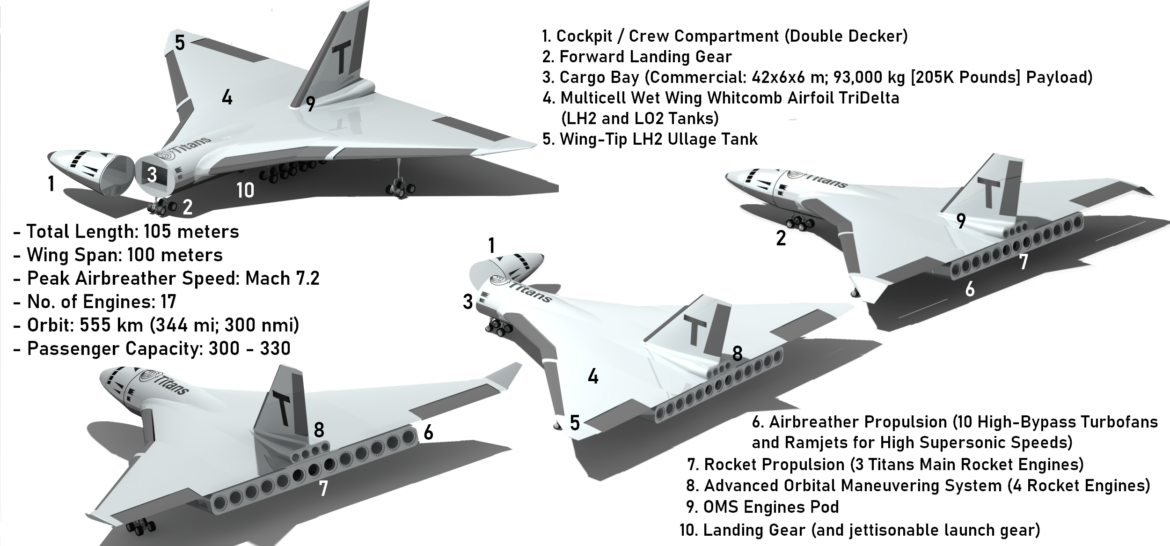
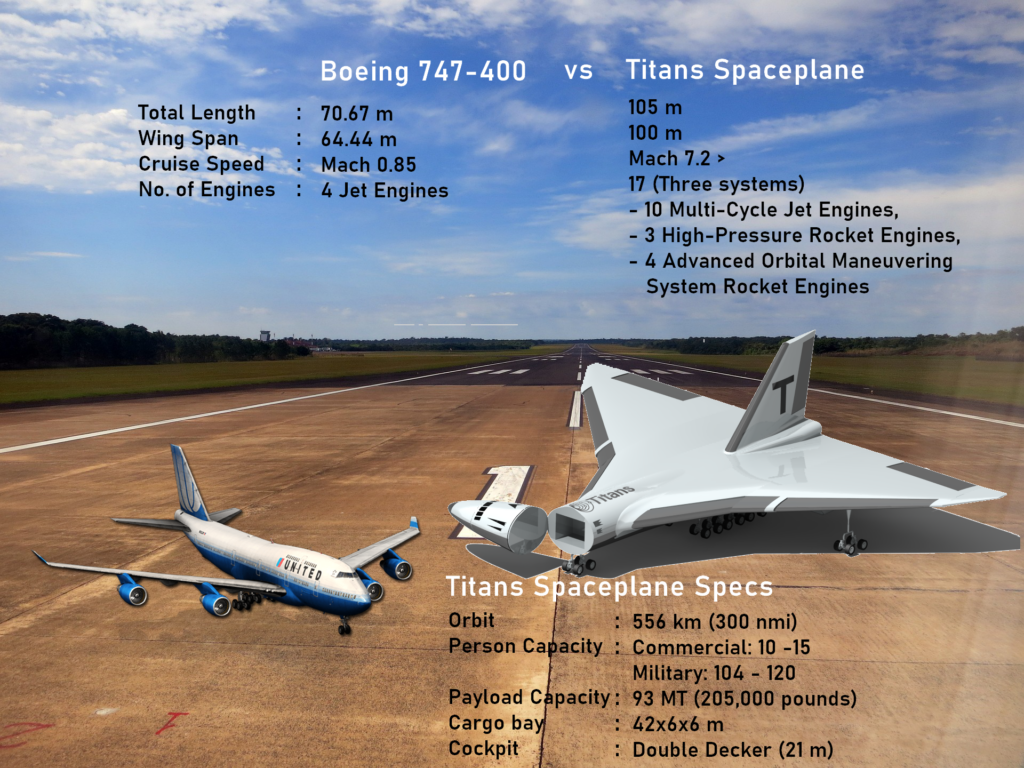
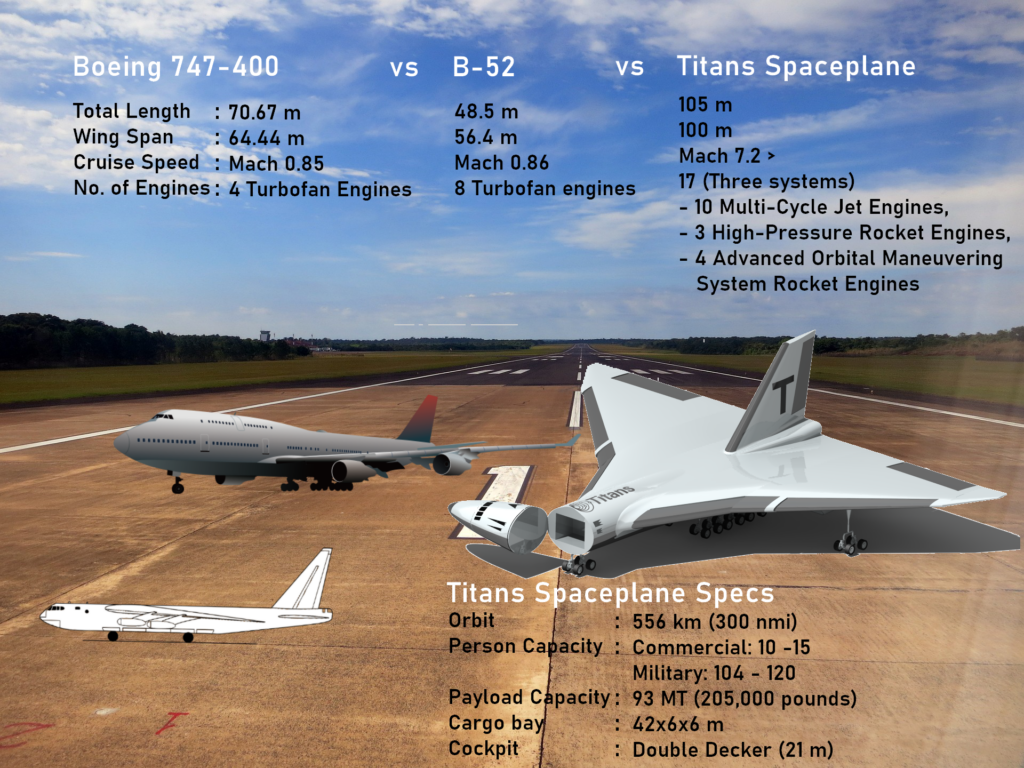
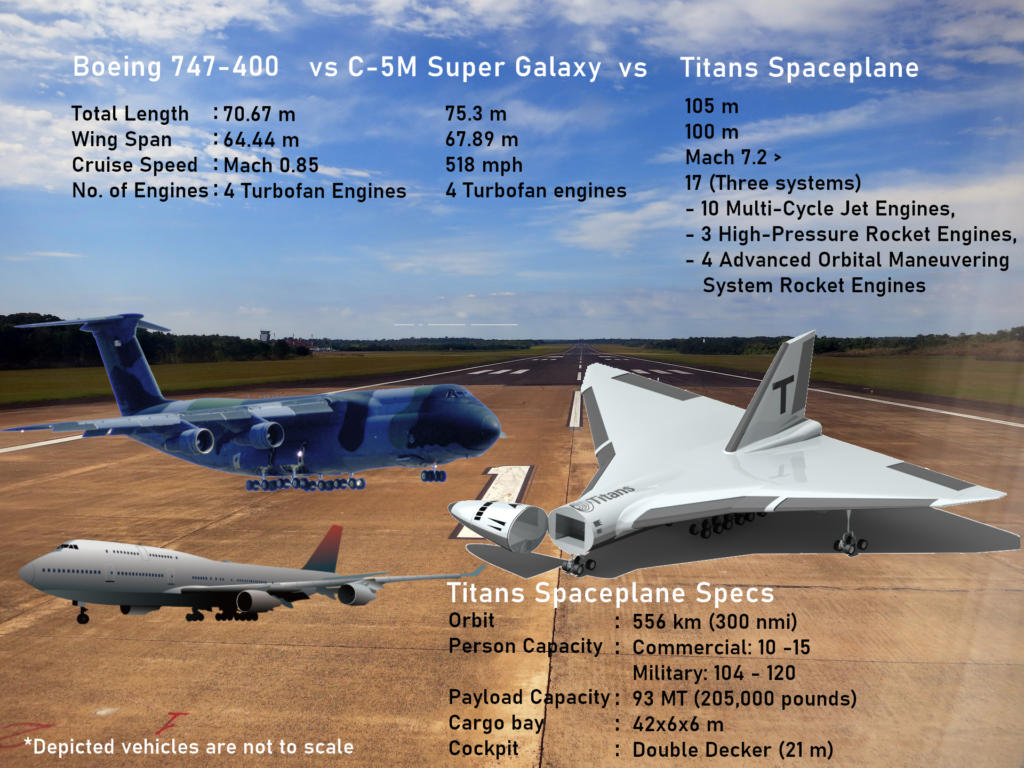
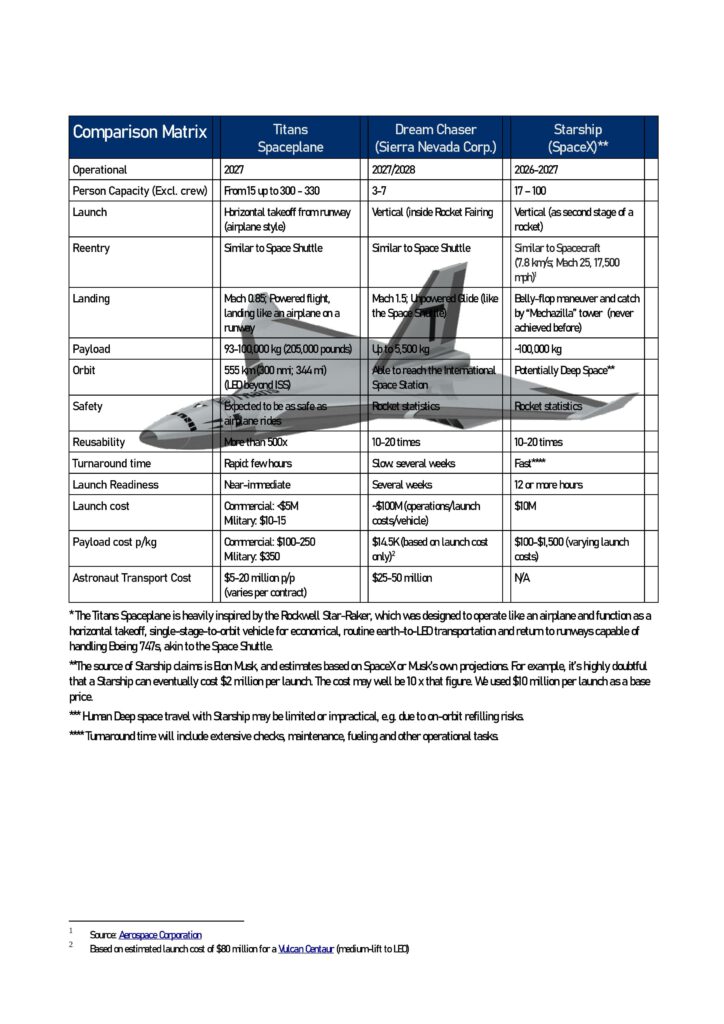
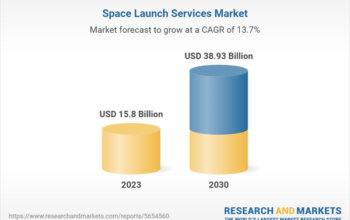

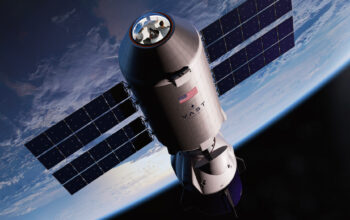
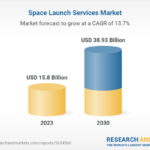


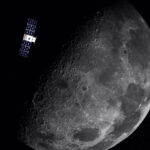




3 thoughts on “Much Safer than Rockets: Titans Spaceplanes, Revolutionizing Space Travel and Space Launches”